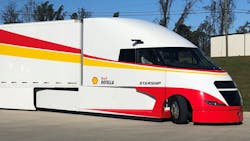Shell Starship 2.0 launches cross-country trip in May
This May, Shell Lubricants will send its Starship 2.0 across the U.S. in attempt to reach the final frontier of efficiency and demonstrate what is possible in a carbon neutral future. And like the previous iteration launched three years earlier, this Class 8 “hyper fuel-efficient truck,” as Shell calls it, will be outfitted with the latest fuel-efficient upgrades, along with a new chassis, drivetrain, and safety equipment.
“Shell Starship 2.0 will feature technologies that have advanced since its inception and is built to stimulate discussion and drive the conversation around trucking efficiency and carbon reduction,” said Jeff Priborsky, global marketing manager for Shell Lubricants on-highway fleet sector. “We have taken a number of technologies and have drawn them together in a single design with a holistic, connected approach that is crafted to optimize performance and efficiency.”
This new technology will be tested along the same route as the first Starship, starting in San Diego, Calif., and ending in Jacksonville, Fla., with the North American Council for Freight Efficiency (NACFE) again monitoring and verifying results.
Shell will measure success using freight ton efficiency, which combines the weight of cargo being moved with the amount of fuel consumed, as the primary metric. Shell believes this is the most relevant statistic for judging energy intensity associated with moving cargo between two points.
And finding the least energy intense way to move the most cargo is one of the trucking industry’s primary ambitions, with lower fuel costs being the driver. With companies such as Shell pledging to become carbon neutral by 2050, reducing emission has moved to the front seat.
“Trucks move freight — and the more freight moved per gallon of fuel or other energy metric is best,” reasoned Mike Roeth, NACFE’s executive director. “If one was set on maximizing mpg, that would encourage running light or empty. Not all carriers can add weight, but technologies like load matching should be exploited and where possible add freight. Filling trailers is the responsibility of the whole freight ecosystem.”
The Shell Starship 2.0 will haul an expected 40,000-lb. payload, 33% more than in 2018, when the truck attained 178.4 ton-miles per gallon for Freight Ton Efficiency. This was almost a 248% improvement over the N.A. average of 72 ton-miles per gallon for trucks. As far as fuel efficiency, the first Starship improved the N.A. average of 6.4 mpg to 8.94 mpg.
Whether cresting 10 mpg is possible remains to be seen, but since the pioneering excursion, the industry overall has made improvements to aerodynamics and low rolling resistance tires, and Shell can leverage something it didn’t have with the first Starship: experience.
The team is looking to also glean new insights by taking the super truck through a variety of environments.
“The ability to test Shell Starship 2.0 under different road and operating conditions is a great benefit as we prepare for the cross-country journey,” said Robert Mainwaring, Shell Lubricants technology manager for innovation. “With many updates to the truck, it has given us the opportunity to make sure the new drivetrain and the efficient technologies built into the truck are all operating in concert with each other.”
About the Author
FleetOwner Staff
Our Editorial Team
Kevin Jones, Editorial Director, Commercial Vehicle Group
Josh Fisher, Editor-in-Chief
Jade Brasher, Senior Editor
Jeremy Wolfe, Editor
Jenna Hume, Digital Editor
Eric Van Egeren, Art Director
